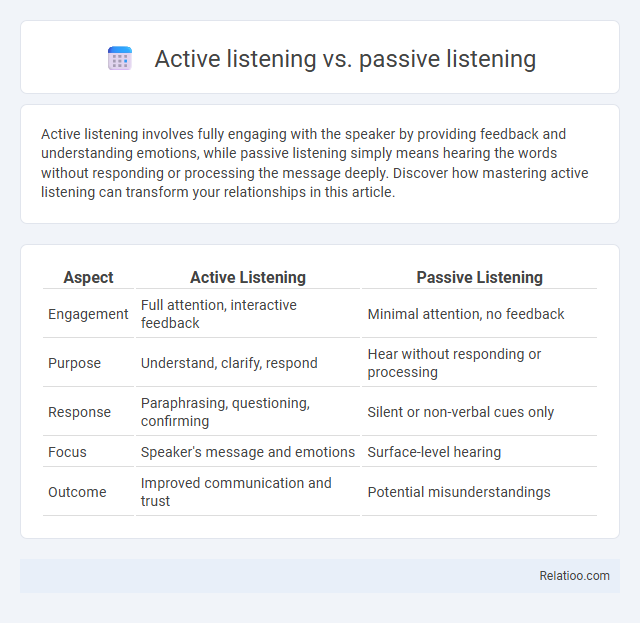Active listening involves fully engaging with the speaker by providing feedback and understanding emotions, while passive listening simply means hearing the words without responding or processing the message deeply. Discover how mastering active listening can transform your relationships in this article.
Table of Comparison
| Aspect | Active Listening | Passive Listening |
|---|---|---|
| Engagement | Full attention, interactive feedback | Minimal attention, no feedback |
| Purpose | Understand, clarify, respond | Hear without responding or processing |
| Response | Paraphrasing, questioning, confirming | Silent or non-verbal cues only |
| Focus | Speaker's message and emotions | Surface-level hearing |
| Outcome | Improved communication and trust | Potential misunderstandings |
Introduction to Active and Passive Listening
Active listening involves fully engaging with the speaker by providing feedback, asking questions, and demonstrating understanding, which enhances communication effectiveness. Passive listening, on the other hand, entails hearing the message without responding or critically processing the information, often leading to missed details and misunderstandings. Your ability to distinguish between active and passive listening can significantly improve interpersonal interactions and information retention.
Defining Active Listening
Active listening involves fully concentrating, understanding, and responding thoughtfully to the speaker, making sure you genuinely grasp their message. Unlike passive listening, which is merely hearing without engagement, active listening requires your intentional effort to clarify and reflect on the information. Your ability to practice active listening enhances communication effectiveness and builds stronger interpersonal relationships.
Understanding Passive Listening
Active listening involves fully engaging with the speaker by providing feedback and asking questions to ensure comprehension, while passive listening means hearing the words without processing or responding thoughtfully. Understanding passive listening is crucial because it highlights moments when you may miss key details or emotional cues, limiting effective communication and relationship building. Enhancing your listening skills requires shifting from passive to active listening to foster deeper connections and better information retention.
Key Differences Between Active and Passive Listening
Active listening involves fully concentrating, understanding, and responding to the speaker, enhancing communication effectiveness, while passive listening requires minimal engagement, often leading to missed key information. Key differences include active listening's emphasis on feedback through questioning and summarizing, whereas passive listening lacks interaction and critical evaluation. Active listening improves retention and empathy, making it essential for effective interpersonal communication, unlike passive listening which often results in superficial understanding.
Benefits of Active Listening
Active listening enhances communication by fully engaging with the speaker's message, improving understanding, retention, and empathy. Unlike passive listening, which involves minimal cognitive effort and often leads to missed information, active listening helps You build stronger relationships and resolve conflicts more effectively. Benefits of active listening include increased trust, reduced misunderstandings, and better problem-solving skills in both personal and professional settings.
Drawbacks of Passive Listening
Passive listening often leads to misunderstandings and missed opportunities for meaningful communication because it lacks engagement and feedback. Your ability to retain important information decreases, causing decreased effectiveness in both personal and professional interactions. Active listening, in contrast, enhances comprehension and connection by fostering attentive, responsive dialogue.
Common Barriers to Active Listening
Common barriers to active listening include distractions, such as environmental noise or internal thoughts, which reduce focus and information retention. Prejudgments and biases can distort message interpretation, while emotional reactions may cause listeners to disengage or respond defensively. Overcoming these obstacles requires conscious effort to maintain attention, suspend judgment, and manage emotions to enhance communication effectiveness.
Techniques to Improve Active Listening Skills
Active listening involves fully concentrating, understanding, and responding thoughtfully to the speaker, while passive listening simply entails hearing the words without engagement, and reflective listening emphasizes mirroring the speaker's message to confirm understanding. Techniques to improve active listening skills include maintaining eye contact, providing verbal and non-verbal feedback, asking clarifying questions, and summarizing key points to demonstrate attentiveness. Practicing mindfulness and minimizing distractions are essential strategies for enhancing focus and information retention during conversations.
Real-life Examples of Active and Passive Listening
Active listening involves fully concentrating, understanding, and responding to the speaker, as seen when a manager provides feedback by summarizing points and asking clarifying questions during a team meeting. Passive listening occurs when a listener hears the words without engagement or feedback, such as a student nodding quietly in class without taking notes or asking questions. In real-life scenarios, active listening enhances communication effectiveness, while passive listening often leads to misunderstandings or missed information.
Conclusion: Choosing the Right Listening Approach
Choosing the right listening approach depends on Your communication goals and context, where active listening enhances understanding and builds stronger relationships by fully engaging with the speaker. Passive listening may suffice for simple information intake but often leads to missed nuances and reduced retention. Prioritizing active listening in conversations improves empathy, clarity, and effective response, making it the optimal choice for meaningful interactions.

Infographic: Active listening vs Passive listening
 relatioo.com
relatioo.com